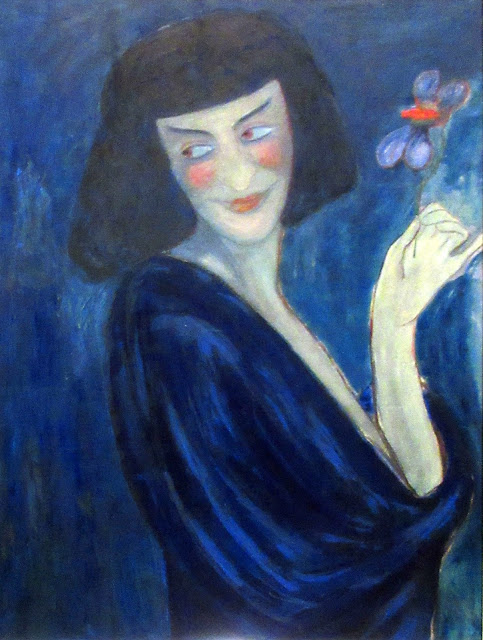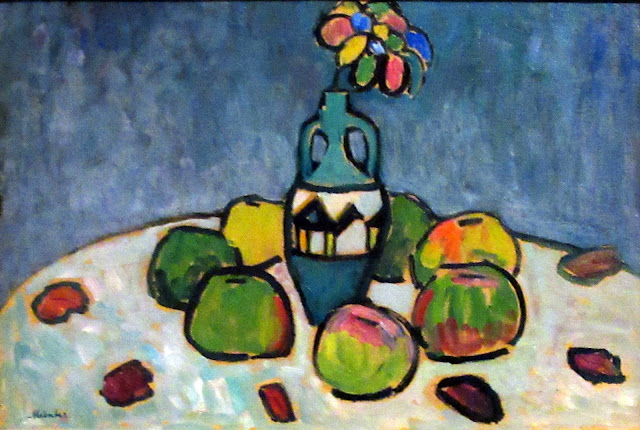'In our case the principle of internationalism is the only one possible... the whole work, called art, knows no borders or nations, only humanity'. (draft preface to the Blue Rider Almanac, 1911).
Expressionists - Kadinsky, Munter and the Blue Rider
at Tate Modern.
Expressionism: bold experiments with colour, dramatic forms, cross-cultural artistic collaborations set against the imperial ideologies and social inequalities of early 20th century Europe. Out of this context emerged a unique transnational community of artists known as the Blue Rider. United by the values outlined in their publication The Blue Rider Almanac, they brought together broad and interconnected experiences, relationships and art practices. The women artists defied social conventions. Many others engaged in environmental issues or searched for new forms of spirituality.
The early 1900s was a turbulent age, and the Blue Rider artists experienced wars, revolutions and the dominance of extreme ideologies. Some artists lost their lives, while others were left bereft, stateless, displaced and persecuted. But for a brief moment before the outbreak of WWI, their experimentation and belief in the transformative power of creativity played a decisive role in the making of European modern art. The core couple of the Blue Rider collective were Wassily Kandinsky and Gabriele Munter.
As a 22-year-old law student, Kandinsky undertook a short ethnographic field trip to the north-eastern Vologda provinde of the Russian Empire. Kandinsky identified his experience with the art, culture and traditions of the local Finno-Ugric Komi people as a turning point in his personal journey from academic research to creative practice. The trip also ignited Kandinsky's awareness of his own cultural heritage - his ancestry included Finno-Ugric Mansi people and Buryats from south-eastern Siberia, as well as Russians and Germans. The Komi buildings Kandinsky recorded in his travel journal can be spotted in the back ground of his early fairy-tale works such as Riding Couple.
Marianne Werefkin, Self-Portrait, 1910, (tempera on paper + card)
Robert, Delaunay, Windows Open Simultaneously, 1912, (oil on canvas)
Gabriele Munter, Man at the Table (Kandinsky), 1911, (oil on card)
Gabriele Munter, Listening (Portrait of Jawlensky), 1909, (oil on card)
Gabriele Munter, Olga von Hartman, 1910, (oil on canvas)
Elisabeth Epstein, Self Portrait, 1911, (oil on card)
Wassily Kandinsky, Kallmunz - Gabriele Munter, Painting II, 1903, (oil on canvas)
Alexej Jawlensky, Spanish Woman, 1913, (oil on card)
Dancer and performer Alexander Sacharoff is the sitter in Spanish Woman. The painting belongs to a series featuring Sacharoff in crossdress, exploring gender fluidity through art and performance.
Franz Marc, Portrait of Maria Franck with a Palette, 1906, (oil on canvas)
Munich: The Politics of Looking
August Macke, Portrait with Apples (Elisabeth with Apples), 1909, (oil on canvas)
Dancer and performer Alexander Sacharoff is the sitter in Spanish Woman. The painting belongs to a series featuring Sacharoff in crossdress, exploring gender fluidity through art and performance.
Munich: The Politics of Looking
The Blue Rider was a largely Munich-based collective as the city provided a relatively liberal and open environment, attracting marginalised artists from less tolerant societies. This includes artists with Jewish ancestry from Eastern Europe and North America (Epstein, Bloch), artists from the more conservative Russian and Austro-Hungarian Empires (Sacharoff, Bossi), those who didn't fit socially within their own middle class privileged social group (Kandinsky, Feininger) or those in pursuit of unconventional romantic partherships (Werefkin, Jawlensky).
Kandinsky was one of the first artists of the Blue Rider circle to move to the bohemian district of Schwabing which housed both the university and the Academy of Fine Arts. Kandinsky recalled: 'Schwabing... in every house one found at least two ateliers under the roof... Schwabing was a spiritual island in the great world, in Germany, mostly in Munich itself. There I lived for many years. There I painted the first abstract picture. There I concerned myself with thoughts about 'pure' painting, pure art'.
Wassily Kandinsky, Interior (My Dining Room), 1909, (oil on card)
Wassily Kandinsky, Munich - Before the City, 1908, (oil on card)
Wassily Kandinsky, Impression IV (Gendarme), 1911, (oil on canvas)
Performing Gender:
Werefkin was attracted to the free arts of street theatre and popular entertainment for their freedom of expression and potential to disrupt the highly regulated social structures women were confined to.
She experimented with expressionist painting while also grappling with questions of identity. This included navigating the legal and social barriers of gender inequality. Her privileged upbringing and financial independence allowed Werefkin to assume a position of power, acting as patron and supporter of the arts - a field traditionally monopolished by men. In this period, such women were given the pejorative label 'manwoman' to denote their behaviour as 'unatural', members of a 'third sex'.
Resenting gender binaries, Werefkin stated: 'I am not a man, I am not a woman, I am I'. She shared affinities with artists challenging traditional gender roles. This is reflected in her support of performer Sacharoff. Presenting androgynously both on and off stage, Sacharoff explored gender fluuidity through new styles of performance that activated form through free movement.
Marianne Werefkin, The Dancer, Alexander Sacharoff, 1909. (tempera on paper on board)
This portrait of the dancer in the role of Salome is a powerful celebration of the body, transgressing the sexualisation of the male gaze. Rejecting both traditional and modernist modes of bodily representation, the image of Sacharoff challenges turn-of-the-century societal norms and expectations.
Murnau: The Possibility of Place
Murnau, a rural town in the foothills of the Bavarian Alps by the shores of the Staffelsee lake, became a place of artistic exchange and inspiration for the Blue Rider artists. It became a site of creative collaboration that laid the founcations of the Blue Rider. The artists embraced a country lifestyle, swimming in the lake and skiing in the mountains. They also designed their own garden, growing a vegetable patch and using the produce for the household and their guests.
They engaged with local arts and crafts, including reverse glass painting. This method consists of painting pictures on the back of a clear glass panel. Viewed from the opposite side of the glass, the colours appear bold and reminiscent of enamels. Munter was the first to learn the technique.
Wassily Kandinsky, Murnau - Johannisstrasse from a Window of the Griesbrau, 1908, (oil on cardboard)
The tranquillity of Murnau allowed Kandinsky to experiment more freely as he moved towards abstract painting. For Kandinsky, abstracted forms are associated with expressions of spirituality rather than the 'purposeless' realism of academic paintings. In Murnau, he adopted bold, saturated colour responding to recognisable features of the local landscape and architecture in the free and spontaneous manner of his early fairy-tale works.
The tranquillity of Murnau allowed Kandinsky to experiment more freely as he moved towards abstract painting. For Kandinsky, abstracted forms are associated with expressions of spirituality rather than the 'purposeless' realism of academic paintings. In Murnau, he adopted bold, saturated colour responding to recognisable features of the local landscape and architecture in the free and spontaneous manner of his early fairy-tale works.
This is one of many portraits Munter painted in Murnau. She recalled, 'I painted the Werefkina in 1909 before the yellow basement of my house. She was a woman of grand appearance, self-confident, commanding, extravatangly dressed, with a hat as big as a wagon wheel, on which there was room for all sorts of things'.
Through simplified forms, a bold colour palette and a carefully framed composition, Munter playfully subverts an intimate domestic setting. She reflected on these early Murnau paintings: 'After a short period of agony, I took a great leap forward, from copying nature - in a more or less impressionist style - to feeling the contents of things, abstracting, conveying an essence. It was wonferful, interesting, enjoyable time, with lots of conversations about art...'
Wassily Kandinsky, Murnay - View with Railway and Castle, 1909, (oil on card)
Alexej Jawlensky, Landscape near Murnau, 1909, (oil on card)
Gabriele Munter, Grave Crosses in Kochel, 1909, (oil on card)
Gabriele Munter, Jawlensky and Werefkin, 1909, (oil on card)
The Inner Necessity of Art:
'Art was concerned with the most profound matters, that renewal must not be merely formal but a rebirth of thinking'. Franz Marc, 1914
The Blue RIder circle's aesthetic concerns developed in parallel with their belief in the deep spiritual significance of artistic experimentation. This drove their creative investigations of form, colour, sound and the performing arts.
Kandinsky's 1912 book Concerning the Spiritual in Art communicated a vision for a new, great spiritual age, in which all art forms would coalesce. His notion of artists' 'inner necessity' described an inherent drive or will towards spiritual expression. Similarly, an interest in the inner creativity and spirituality of children was prominent in scientific and academic research at the turn of the the century. This was captured in feminist publications such as Swedish writer Ellen Key's The Century of the Child, published in 1900. It marked a cultural shift that recognised the inner life of children, including their natural spirituality and original creativity. Franck-Marc's work reveals deep engagement with the subject.
Franck-Marc's vibrant expressive paintings explore the spiritual lives of children realised through imaginative and creative play. The early 20th century saw significant advancements in developmental studies, feminist theory and educational reform movements in Germany. Popular academic publications ranged from feminist writings to developmental psychology. Franck-Marck's compositions were included in the Blue Rider's second exhibition in 1912, offering a subversive side to modernist's engagement with manifold manifestations of spirituality.
Maria Franck-Marc, Girl with Toddler, 1913, (oil on canvas)















































No comments:
Post a Comment